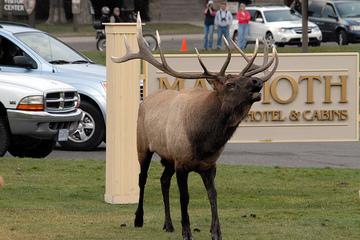1. The collared lizards that inhabit many rocky desert parks like Arches National Park signal dominance and breeding condition by
a. flaring a brightly-colored dewlap about ten inches wide
b. inhaling air and swelling to twice normal size
c. making very loud hissing and "booming" sounds
d. bobbing up and down in "push-up" fashion
2. The _____ that inhabit Canyonlands National Park and some other arid western places deposit eggs that can dry out, remain viable for several years, and hatch within 30 hours when rehydrated.
a. common toads
b. fairy shrimp
c. gila monsters
d. pupfish
3. In Rocky Mountain National Park, where listening to elk bugling is a popular visitor activity each fall, the onset of the elk rut is determined principally by
a. the length of the daylight period
b. the first snowfall of the season
c. decreasing daytime temperatures
d. a shift in the prevailing wind direction
4. The gray whale calves traveling north with their mothers during late spring, and which can be seen from the shore at Cabrillo National Monument and several other Pacific Coast national parks, are nearly all born in
a. Baja California lagoons
b. the Galapagos Islands vicinity
c. coastal Hawaiian waters
d. Patagonia or Antarctica
5. Which of the following animals that can be found in America's national parks release the greatest number of eggs during a single spawning?
a. horse shoe crab
b. Chinook salmon
c. oyster
d. lobster
6. True or false? To offset heavy predation losses, female harbor seals at Point Reyes National Seashore commonly give birth to twins.
7. True or false? Ospreys build the largest bird nests found in national parks of the eastern United States.
8. True or false? The coho salmon that spawn in an Alaskan national park die after spawning.
9. True or false? Female cottontail rabbits born in Shenandoah National Park can be expected to reach breeding age in about 90 days.
10. True or false? The typical female opossum in Buffalo National River gives birth less than two weeks after mating.
Extra Credit Question:
11. A mature male grizzly that encounters a sow grizzly with cubs is likely to kill the cubs if he gets the chance. What is the scientific explanation for this behavior?
Super Bonus Question:
12. Standing on his hind feet, and remaining about six feet from his target, the male of one mammal species living in Pictured Rocks National Lakeshore sprays copious amounts of urine on a female he hopes to mate with. Do you know which animal this is?
Answers:
(1) d -- Collared lizards signal dominance and breeding condition by raising up on their legs and then bobbing up and down as though they were doing pushups. They may pause to do this at intervals while skittering across rock surfaces.
(2) b -- The many species of fairy shrimp that inhabit pot holes, vernal springs, and other ephemeral pools in various arid western places deposit eggs that can survive long stretches of drought after the pools dry out. When the pools refill, the eggs must hatch quickly because the pools won't last very long.
(3) a -- Scientific research has confirmed that the onset of elk bugling, a trademark feature of the elk rut, is triggered by changes in the length of the daylight period (photoperiod).
(4) a -- Nearly all calving and mating takes place in the Baja California lagoons, which is where gray whales overwinter. Calving can occur during migration, but it's been rarely documented.
(5) c -- An oyster in its female stage (they are hermaphroditic) releases roughly five million eggs when it spawns, while a big lobster releases 100,000, a horseshoe crab releases around 20,000, and a Chinook salmon releases around 4,000.
(6) False. Female harbor seals can care for only one pup, so multiple births rarely occur. When they do, only the healthiest pup survives.
(7) False. Bald eagles build the largest bird nests in North America. Some bald eagle nests are eight feet wide and weigh more than a ton.
(8) True. All Pacific salmon die after they spawn.
(9) True. Most female eastern cottontails are sexually mature by the time they are three months old.
(10) True. A female opossum will usually give birth to eight or so very tiny offspring (sometimes as many as 20) within 11-13 days. The ones lucky enough to make their way to her pouch, which provides sustenance and protection, are carried there for around 2 1/2 months while they develop.
(11) If a female grizzly loses her cub(s), she will be receptive to breeding again. A male grizzly that manages to kill a sow's cubs gets the chance to breed with her and pass his own genes along to the offspring.
(12) The animal is a male porcupine. Just why he would risk peeing on a creature equipped with more than 30,000 sharp quills is something most people find hard to fathom (though it's not surprising that he stands off a good ways while doing this). Female porcupines, BTW, are sexually receptive only about 8 to 12 hours a year.
Grading: 9 or 10 correct, rest on your laurels; 7 or 8 correct, pretty darn good; 6 correct, passable fair; 5 or fewer correct, nothing to brag about.






